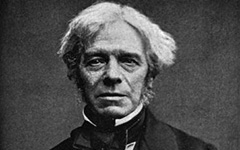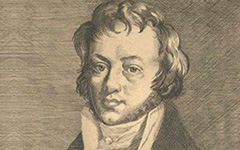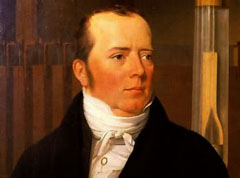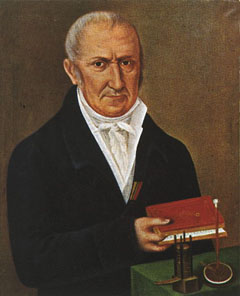Home > Science > The Dawn of Electricity > The First Inventors
The First Inventors
In the early 19th century, an increasing number of scientists became interested in electricity. Publication of their research results and new experiments led to the development of theories and a better understanding of electrical phenomena. Each scientist's contribution allowed others to make progress. In less than one hundred years, the sum of their work led to the production and distribution of electricity over short distances.
The invention of the Voltaic Pile in 1800 by Italian professor of physics Alessandro Volta marked the beginning of a series of important discoveries in electricity. Inspired by the work of fellow-countryman physician Luigi Galvani on the connection between electricity and the nervous system of the frog, Volta developed the first electric cell capable of producing direct current.
Volta built his aptly named Pile by creating a pile of alternating silver and zinc washers, each separated from the other by means of cloth soaked in salt water. At the time, Volta thought that electricity was produced by contact between the two metals rather than as a result of chemical reaction. His invention would remove the study of electricity from the realm of curiosity and propel it directly into scientific laboratories.
In France, André-Marie Ampère, professor of chemistry and physics, also drew on work by another researcher, Christian Oersted. In1820, this Danish physicist discovered that an electric current produced a magnetic field. A few weeks after the announcement of Oersted's results, Ampère succeeded in making a coil (solenoid) to create a magnetic field. He was the first to scientifically establish a link between electricity and magnetism.
Ampère's work in turn inspired British physicist Michael Faraday. In 1831, he demonstrated that a magnet in movement near a metal wire produced an electric current in the wire. In the United States in 1828, unaware of Faraday's research, another physicist named Joseph Henry designed an electromagnet that used the same principle, but in reverse. Both men proved that electricity could be produced at will by moving a magnet and its magnetic field within a coil of metal wire. A continuous displacement of free electrons, or electricity, in the wire was then observed.
The work of Faraday and Henry inspired other scientists and accelerated discoveries. In 1882, Croatian engineer Nikola Tesla perfected the alternator, a device capable, as its names indicates, of producing an electrical current that alternates constantly back and forth on a messenger wire. The same year, French chemist Lucien Gaulard presented a transformer capable of changing the voltage of alternating current. These two inventions greatly facilitated the large-scale production and transportation of electrical energy over long distances.
At the onset of the 1880s in the United States, inventor Thomas Edison and engineer George Westinghouse were in a fight to the finish in the production and transportation of electricity. Edison was an ardent champion of direct current, while Westinghouse preferred alternating current. The choice of alternating current for the universal exhibition in Chicago in 1893, and above all, the design of the Niagara Falls Powerhouse in 1895, confirmed the advantages of alternating current.
The contribution of Thomas Edison warrants praise, nonetheless, for his invention of the light bulb for indoor lighting in the home in 1879. Three years later, he activated the first power station in America. This power station, equipped with six generators, provided direct current to 85 buildings on Wall Street in New York.















